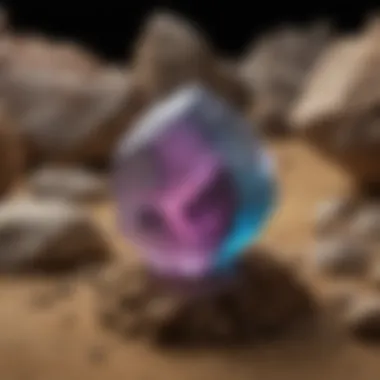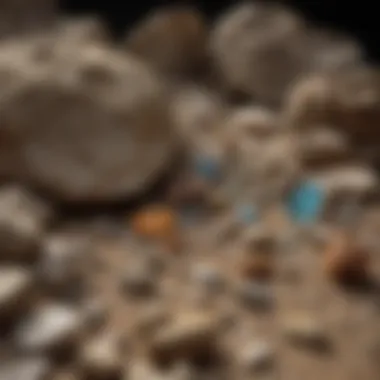Unveiling the Wonders of Short Wave UV Mineral Light: A Comprehensive Exploration


Rock and Fossil Identification
In the world of mineral exploration, understanding the nuances of short wave UV mineral light is paramount. Rock and fossil collectors immerse themselves in the intricate details that define various types of rocks and fossils under this specialized light source. Not all rocks and fossils react the same way, so collectors need to be well-versed in the characteristics to look for under short wave UV illumination. This includes discerning fluorescence patterns, color variations, and unique markings that are illuminated by the UV light. To aid in this process, collectors rely on specific tools for identification such as UV mineral lights, magnifying lenses, and UV protective eyewear.
Collecting Tips and Techniques
When delving into the realm of short wave UV mineral light, rock and fossil enthusiasts need to adhere to best practices for collecting specimens. This involves conducting thorough research to locate prime collecting sites that are known for yielding a diverse range of fluorescent minerals. Such sites are often tucked away in remote locations or within specific geological formations that harbor these special minerals. Once at a collecting site, it is essential to employ safe extraction techniques to ensure the integrity of the specimens. This may involve using delicate tools like chisels, hammers, and brushes to carefully extract rocks and fossils without causing damage.
Preservation and Display
Preserving the beauty and integrity of collected rocks and fossils is a crucial aspect of rock and fossil collecting under short wave UV mineral light. Enthusiasts employ various techniques for preservation, including cleaning specimens with gentle brushes or specialized cleaning solutions to maintain their fluorescence. Proper storage methods are also essential to prevent degradation of the specimens over time. This often involves storing minerals in individual compartments within a display case or utilizing protective cases to shield them from external elements. For creative display ideas, collectors may arrange specimens based on their fluorescence properties, creating captivating visual displays that highlight the diverse beauty of fluorescent minerals.
Geological Insights
Delving deeper into the world of short wave UV mineral light unveils fascinating geological insights that shed light on the historical significance of rocks and fossils. Exploring different geological formations and processes through the lens of UV light offers a unique perspective on the formation and composition of minerals. Additionally, understanding the historical significance of certain rocks and fossils provides context to the intricate interplay between geology and fluorescence. Notable discoveries in the field of short wave UV mineral light have led to exciting advancements in mineral identification and enriched our understanding of Earth's geological heritage.
Introduction to Short Wave UV Mineral Light
Short wave UV mineral light unveils a world of intrigue and discovery in the realm of rock and fossil collecting. This section serves as a beacon illuminating the significance of short wave UV light, shedding light on its indispensable role in mineral identification. From its unique properties to its practical applications, the exploration of short wave UV mineral light promises a transformative journey for enthusiasts and experts alike.
Understanding Short Wave UV Light
Definition and Characteristics
Short wave UV light is characterized by its ultra-short wavelengths, falling within the UV-C spectrum, making it a fundamental tool for mineral analysis. The key characteristic of short wave UV light lies in its ability to reveal fluorescence patterns in minerals, aiding in their identification. Its unique feature of strong energy penetration enables thorough mineral inspection, although careful handling is crucial due to its high energy levels.
Sources of Short Wave UV Light
The sources of short wave UV light predominantly include specialized lamps and LED lights emitting UV radiation. These sources play a vital role in mineral identification by providing the necessary illumination for observing fluorescence patterns. Their portability and efficiency make them a popular choice for rock and fossil collectors. However, control measures must be heeded to prevent potential skin damage or eye injuries from direct exposure to the intense radiations.


Historical Significance
Discovery and Evolution
The discovery of short wave UV light revolutionized mineral research, enabling scientists to uncover fluorescence phenomena, and understand mineral compositions. Its evolution over time has led to the development of advanced lighting technologies tailored for precise mineral examination. Despite its immense advantages, the historical significance of short wave UV light also highlights the need for responsible usage to avoid any adverse health effects.
Importance in Geology
Role in Mineral Identification
Short wave UV light plays a pivotal role in mineral identification by highlighting unique fluorescence patterns specific to different minerals. Its key characteristic lies in effectively distinguishing minerals based on their reactivity to UV light. Although invaluable in geology, the use of short wave UV light requires caution to prevent unnecessary exposure to potentially harmful radiation, balancing between exploration and safety precautions.
Properties of Short Wave UV Mineral Light
Short Wave UV mineral light plays a crucial role in the field of rock and fossil collecting, offering valuable insights into mineral identification and characteristics. Understanding the specific wavelengths and energy levels of short wave UV light aids collectors in distinguishing various minerals based on their unique fluorescence patterns when exposed to this light source. These properties enable enthusiasts and experts to uncover hidden features and authenticate specimens with precision and accuracy. Moreover, the effect of short wave UV light on minerals provides a detailed understanding of how different specimens react when subjected to UV illumination, enhancing the overall experience of collecting and studying rocks and fossils.
Wavelength and Energy
UV-C Spectrum
The UV-C spectrum, known for its shorter wavelengths and higher energy levels, is instrumental in revealing fluorescence patterns in minerals. Its ability to penetrate deep into specimens unveils intricate details that may go unnoticed under visible light. Collectors benefit significantly from utilizing UV-C light due to its effectiveness in highlighting mineral characteristics that are not apparent through conventional viewing methods. While UV-C spectrum offers unparalleled insights, it is essential to handle this light source with caution to avoid potential harm to the skin and eyes.
UV-A Spectrum
Contrary to UV-C, the UV-A spectrum comprises longer wavelengths with lower energy, making it a safer option for mineral observation. Despite its lower energy levels, UV-A light remains invaluable in showcasing fluorescence patterns and mineral reactions under UV illumination. Rock and fossil collectors often prefer UV-A light for its versatility and reduced risk of causing damage, allowing for prolonged observation periods without compromising safety. Understanding the unique features of UV-A spectrum can significantly enhance the mineral identification process, contributing to a more comprehensive rock and fossil collection experience.
Effect on Minerals
Fluorescence Patterns


Fluorescence patterns induced by short wave UV light offer a distinctive way to identify and differentiate minerals based on their individual responses to UV exposure. Various minerals exhibit specific fluorescence colors and intensities when illuminated with UV light, aiding collectors in classifying and categorizing specimens accurately. The ability to observe fluorescence patterns provides crucial insights into mineral composition and aids in distinguishing between similar-looking rocks and fossils, facilitating a more precise identification process.
Mineral Reaction to UV Light
Minerals react differently when exposed to short wave UV light, showcasing unique behaviors and responses that help collectors assess their authenticity and characteristics. Understanding how minerals interact with UV illumination enables collectors to determine the presence of certain elements or impurities within specimens, assisting in the authentication and evaluation of rock and fossil samples. By studying mineral reactions to UV light, enthusiasts can delve deeper into the geological history and composition of their collections, unraveling the mysteries hidden within each specimen with meticulous observation and analysis.
Applications in Rock and Fossil Collecting
Short wave UV mineral light plays a crucial role in rock and fossil collecting, elevating the identification process to new heights. By utilizing short wave UV light, collectors can easily distinguish between different minerals based on their fluorescence patterns, leading to accurate identifications. The ability to unveil hidden features that are not visible under regular light enhances the collecting experience, allowing enthusiasts to explore specimens in detail. Furthermore, the authentication of specimens is simplified through the use of short wave UV light, ensuring the genuineness of collected rocks and fossils.
Mineral Identification Techniques
Use of Short Wave UV Light:
In the realm of mineral identification, the use of short wave UV light proves to be a valuable tool for collectors. Its unique characteristic of revealing fluorescence patterns in minerals aids in distinguishing one mineral from another. This method enhances the overall accuracy and efficiency of mineral identification, providing collectors with a reliable means of classifying their specimens. Despite its effectiveness, it is essential to note that prolonged exposure to short wave UV light can sometimes alter the fluorescence of certain minerals, requiring careful consideration during use.
Enhancing Collecting Experience
Revealing Hidden Features:
Unveiling hidden features is a fundamental aspect of enhancing the rock and fossil collecting experience. Through short wave UV light, collectors can uncover intricate details and patterns that are otherwise invisible to the naked eye. This discovery not only adds depth to the specimens but also reveals hidden characteristics that contribute to their overall uniqueness. While the use of short wave UV light enhances the collecting experience, collectors must exercise caution to prevent overexposure, which can potentially damage delicate minerals.
Authentication of Specimens:
The process of authenticating specimens is significantly streamlined with the incorporation of short wave UV light. By highlighting specific fluorescence patterns unique to authentic minerals, collectors can easily verify the genuineness of their finds. This feature adds a layer of security and reliability to the collecting process, ensuring that enthusiasts are acquiring legitimate specimens for their collections. However, it is essential to acknowledge that while authentication through UV light is efficient, it should always be complemented by other established methods to confirm the validity of specimens.
Safety Measures and Precautions
Safety measures and precautions are paramount when dealing with short wave UV mineral lights, ensuring the well-being of individuals and the longevity of equipment. In the fascinating realm of rock and fossil collecting, understanding and implementing proper safety protocols can significantly enhance the overall experience. These measures not only protect the user from potential harm but also preserve the integrity of specimens under examination. By adhering to safety guidelines, enthusiasts can delve deeper into their passion with confidence and peace of mind.


Protecting Eyes and Skin
UV-Blocking Glasses
UV-Blocking glasses play a critical role in safeguarding the eyes against the harmful effects of short wave UV light. These specially designed glasses are essential in preventing eye strain, minimizing UV radiation exposure, and maintaining visual acuity during mineral inspection. The key characteristic of UV-blocking glasses lies in their ability to filter out harmful UV rays while allowing safe wavelengths to pass through. This makes them a popular and indispensable choice for rock and fossil collectors, ensuring optimal eye protection without compromising visibility. The unique feature of UV-blocking glasses is their specialized lens technology, which significantly reduces the risk of eye damage associated with prolonged UV exposure. While these glasses offer substantial benefits, they may pose limitations in certain lighting conditions or require periodic replacement to maintain efficacy.
Skin Protection
Skin protection is another crucial element to consider when working with short wave UV mineral lights, as prolonged exposure can potentially lead to skin damage. Implementing skin protection measures, such as wearing long-sleeved clothing or applying UV-resistant sunscreen, is vital in safeguarding against UV-induced skin issues. The key characteristic of skin protection in this context is its ability to create a barrier between the skin and UV radiation, reducing the risk of burns or long-term skin damage. This proactive approach is a beneficial choice for enthusiasts, as it prioritizes skin health and overall well-being while engaging in mineral identification activities. The unique feature of skin protection lies in its customizable options, allowing individuals to tailor protection according to their specific needs or exposure levels. While skin protection offers significant advantages, individuals need to be diligent in its application and reapplication to ensure continuous coverage and effectiveness.
Proper Equipment Handling
Proper equipment handling is essential to maintain the functionality and longevity of short wave UV mineral lights, ensuring optimal performance for mineral identification tasks. By adopting sound maintenance practices, collectors can prolong the lifespan of their equipment and minimize the risk of malfunctions during critical inspections. The key characteristic of maintenance practices is their ability to prevent equipment deterioration through regular cleaning, calibration, and storage procedures. This careful attention to equipment care is a popular and beneficial choice for enthusiasts, as it safeguards their investment and enhances the reliability of their tools. The unique feature of maintenance practices is their versatility, allowing individuals to customize maintenance routines based on their specific equipment models and usage patterns. While maintenance practices offer substantial advantages, users must be mindful of potential drawbacks such as time investment and the need for periodic equipment servicing to ensure consistent functionality.
Best Practices for Using Short Wave UV Light
Short Wave UV light is a crucial tool in the toolkit of any avid rock and fossil collector. Understanding the best practices for utilizing this specialized light source is paramount in maximizing its effectiveness. When it comes to optimizing mineral visibility, several key considerations must be taken into account to ensure accurate identification and observation of minerals. One of the primary factors to focus on is the angle and distance at which the UV light is directed towards the mineral samples.
Angle and Distance Considerations
Angle and distance play a vital role in how minerals react to short wave UV light. The angle at which the light is directed can impact the visibility of fluorescence patterns and subtle features in the minerals. By adjusting the angle of the UV light source, collectors can enhance the contrast and clarity of mineral specimens under inspection. Additionally, maintaining an optimal distance between the UV light and the mineral sample aids in promoting uniform illumination and preventing overexposure, which could distort the fluorescence patterns.
Recording Findings
One of the crucial aspects of utilizing short wave UV light is effectively recording findings to ensure accurate documentation and analysis of mineral samples. Logging observations is essential in keeping track of fluorescence patterns, color variations, and any unique characteristics exhibited by minerals under UV light. By maintaining detailed records of observations, collectors can trace patterns, changes, and trends in different mineral specimens over time. This systematic approach not only aids in accurate mineral identification but also facilitates the comparison and analysis of findings for future reference.
Logging Observations
Logging observations involves documenting details such as the type of mineral, fluorescence color, intensity of fluorescence, and any distinguishing features observed under UV light. This meticulous recording process provides a comprehensive overview of the minerals being studied and assists in creating a database of findings for future reference. By logging observations consistently and thoroughly, collectors can build a valuable repository of information that aids in mineral identification, research, and studying fluorescence patterns in various mineral specimens.
Storage Recommendations
Ensuring proper storage of mineral specimens is essential in preserving their integrity and protecting them from light exposure that could potentially alter their fluorescence properties. Recommendations for storing minerals under short wave UV light involve safeguarding them in light-insulated containers or cabinets to minimize exposure to ambient light. By implementing suitable storage practices, collectors can prolong the longevity and maintain the quality of their mineral specimens, preventing any degradation of fluorescence patterns or color intensity due to prolonged light exposure.
Protection from Light Exposure
Protection from light exposure is crucial in maintaining the authenticity and vibrancy of mineral specimens when using short wave UV light. Light-sensitive minerals are susceptible to fading or color alteration when exposed to prolonged light, emphasizing the importance of protecting specimens from unnecessary light exposure. By storing minerals in light-protected containers or cabinets and minimizing exposure to direct light sources, collectors can ensure the longevity and visual appeal of their collection, preserving the fluorescence patterns and unique features that make each mineral specimen distinct.







